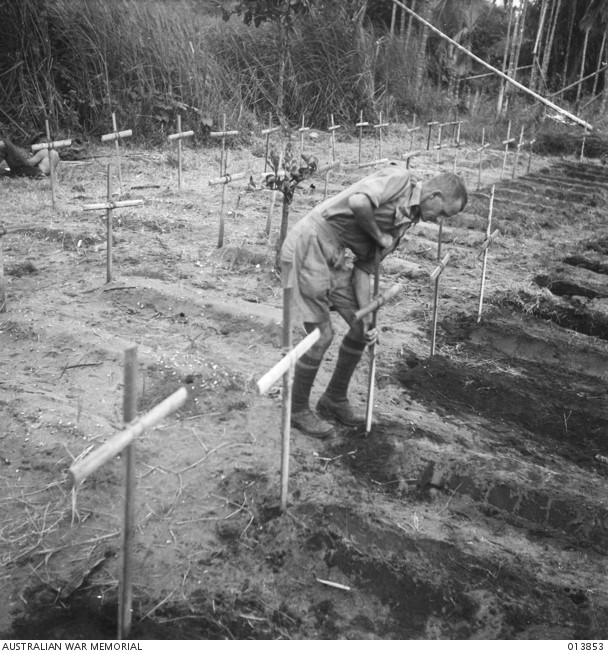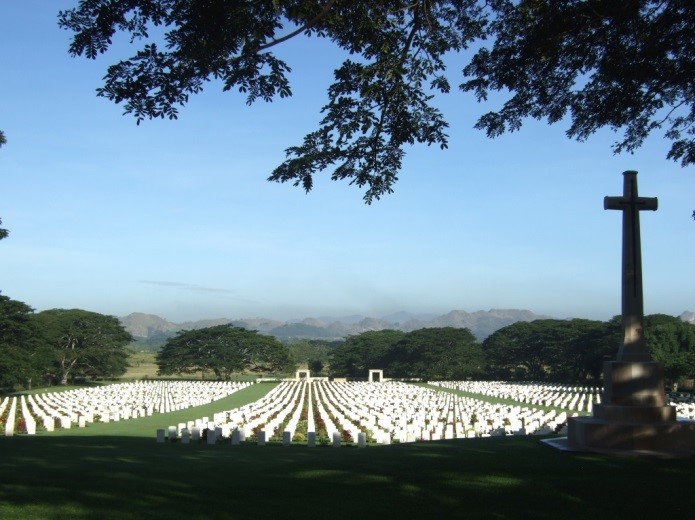Private Alfred George Rye, the son of Herbert Arthur Rye and Ellen Law Rye (nee Fraser), was born at Toowoomba in Queensland on 18th April 1916. He was educated at the Rangeville State School and the Toowoomba Grammar School. At the age of 24 years and 2 months he voluntarily enlisted in the Australian Imperial Force at Toowoomba on 23rd June 1940 after swearing the statutory oath that he would serve for the duration of the war and an additional twelve months. Prior to his enlistment he was single and employed as a Clerk with the Queensland Trustees Ltd. He gave his next of kin as his father, Mr Herbert Arthur Rye, residing at 190 Stuart Street in Toowoomba His father’s address was later changed to Kingsbury Street, Norman Park, East Brisbane on 3rd July 1942. He had previously served for seven weeks in the 25th Infantry Battalion. His physical description at the time of his enlistment was that he had auburn hair and blue eyes. He stated that he was of the Church of England religion.
Private Alfred Rye was allotted the regimental number of QX10189 and he joined the Northern Command Reception Depot in Brisbane. He joined the Infantry Training Depot at Caloundra in Queensland on 25th June 1940. He was allocated to the 2nd/25th Infantry Battalion at Grovely Camp in Brisbane on 19th August 1940. The 2nd/25th Infantry Battalion was formed at Grovely on 1st July 1940. On 11th October the Battalion presented itself to the public of Queensland by marching complete with rifles with bayonets attached through the streets of Brisbane. In the afternoon of 15th October 1940 the Battalion left Grovely Camp and proceeded to the Pinkenba Wharf on the Brisbane River where they boarded the sea transport “Zealandia” for its voyage to Darwin in the Northern Territory via the Queensland Coast and Torres Strait. The battalion disembarked from the ship at Darwin on 23rd October 1940. Intensive training including weapon training, map reading, patrolling, manoeuvres, marches and beach defence was conducted in the Darwin area. On 15th February 1941 the Battalion boarded the “Zealandia” for its return to Queensland. The ship berthed at Brisbane on 24th February 1941 and the unit entrained for Redbank Camp on 24th February 1941.
Private Alfred Rye was granted pre-embarkation leave during the period 28th February until 18th March 1941 to farewell his family and finalize his personal affairs prior to embarking for overseas service in the Australian Imperial Force. His battalion left Brisbane by rail transport on 6th April 1941 and proceeded to Sydney where they boarded a transport ship “Queen Mary” on the following day. The “Queen Mary” departed Sydney for the Middle East early in the morning of 9th April. The “Queen Mary” sailed via Fremantle in Western Australia to Trincomalee Harbour, Ceylon. After leaving Trincomalee the ship sailed to Aden and the Red Sea. It arrived at Port Tufik at the entrance to the Suez Canal on 3rd May 1941. The Battalion disembarked from the ship on 5th May 1941 and proceeded by rail transport to Ikingi Maryut. The Battalion then moved to Mersa Matruh on 9th May 1941 and arrived there shortly after midnight. The Battalion proceeded to Ismailia on 27th May and crossed the Suez Canal by ferry to El Kantara on the Palestine side.
Private Alfred Rye was evacuated to the 7th Australian General Hospital suffering from diarrhoea on 28th May 1941 and he remained a patient at the hospital until 8th June 1941. Upon discharge from hospital he joined the 24th Australian Infantry Training Battalion. He left the Infantry Training Battalion on 26th June 1941 and joined the 2nd/25th Infantry Battalion on the following day. He was evacuated to the 1st Australian General Hospital suffering from dysentery on 25th July 1941 and transferred to the 1st Australian Convalescent Depot on 3rd August 1941. He was discharged from the Convalescent Depot on 11th August 1941 and joined the 24th Australian Infanty Training Battalion later that day. He left the Training Battalion on 15th August 1941 and rejoined the 2nd/25th Battalion later that day.
Private Alfred Rye embarked with his Battalion on the “U.S.S. Mount Vernon” on 8th February 1942 to return to Australia to meet the Japanese threat. The ship arrived at Colombo on the morning of 18th February 1942. The ship left Colombo and arrived at Fremantle on 4th March 1942. The ship set sail for Adelaide and the Battalion disembarked there on the morning of 10th March 1942. The Battalion then moved to Woodside Camp where further military training was carried out. The Battalion moved to Casino in New South Wales during 26th/27th April 1942. He was granted home leave during the period 2nd May until 10th May 1942. On 27th May 1942 the Battalion moved to Caboolture in Queensland where it was assigned a portion of the coast for coast watching.
Private Alfred Rye embarked with his battalion from New Farm Wharf in Brisbane on 31st August 1942 on the ships S.S. Katoomba and S.S. Van Der Lijn and he disembarked at Port Moresby on 9th September 1942. The battalion left the staging camp at Port Moresby and proceeded up the Kokoda Track to engage the retreating Japanese. They had their first action at Ioribaiwa on 14th September 1942 and were involved in many military actions driving the Japanese back Gona. Alfred Rye was killed in action on 23rd November 1942 during the battalion’s attack on Gona Village. He was one of eight battalion members killed during the attack on 23rd November. At the time of his death, Alfred Rye was 26 years of age. After the capture of the beachheads his remains were recovered and buried in the Gona Cemetery on 10th December 1942. After the war his remains were exhumed and reburied in the Port Moresby (Bomana) War Cemetery. His headstone contains the family inscription of: “His duty nobly done, he rests, his sleep is sweet”.

Australian War Memorial photograph 013853
Church of England Padre, A.E.Begbie, pushing a cross into the ground at the head of one of the graves of soldiers who died during the battle for Gona.
Alfred Rye’s photograph and the following report was published in the local newspaper:
The death of Private A.G. Rye took place in action in New Guinea on November 23. He was the eldest son of Mr and Mrs T. A. Rye, Kingsbury Street, Norman Park, Brisbane, and for many years of Stuart Street, Toowoomba. He went to the Rangeville State School and the Toowoomba Grammar School, where he passed the Junior examination, and he then began work with the Queensland Trustees Ltd., after which he passed his accountancy examination. Private Rye played football with Past Grammar teams and cricket with Past Grammar Colts and his slow bowling was a feature of Colts’ cricket. His innings was short but it was a good one. Private Rye joined the A.I.F. in June, 1940, and sailed for the Middle East early in 1941. He served in Egypt, Palestine, Syria and New Guinea. His sisters are Betty (nursing staff of the Toowoomba General Hospital), and Marjorie (formerly of the Toowoomba Telephone Exchange). A brother, Ian, is serving with the Military Forces. Private Rye was 26 years of age.
Note
Alfred Rye’s mother received the Female Relative Badge with one star on 19th October 1942 and the Mothers’ and Widows’ Badge with one star on 10th July 1943.




